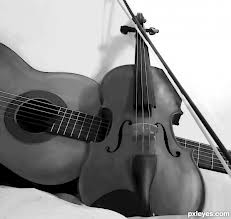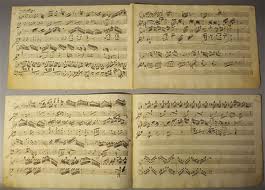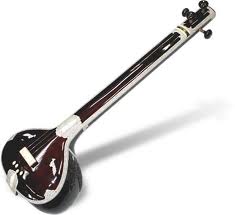A few years ago, a conversation with the wrong person, about learning music, included the following exchange –
“You’re learning the violin? Dude, why don’t you learn the guitar, it’s so cool and easy. It has a ‘youthful touch’ to it,” the guy ignorantly suggested while making a jeering mockery of the Indian solfège.
“Do you even know how many strings a guitar has?” I asked him, conspicuously annoyed.
The conversation ended with no resolution of the question of the ‘youthful touch’ he so animatedly advertised. ‘Youthful touch’? What the hell did he even mean by that? I wonder, to this day! Back then, taking pictures with a guitar, holding it in ridiculous positions to look ‘cool’, was a fad. Also, it turned out, he didn’t know squat about music. If he really were learning the guitar and understood the nuances of learning the instrument, he wouldn’t have quacked the way he did. Anyway, shocked as I was, I began to wonder – Why is it so hard for people to understand that learning any musical instrument is an unforgiving challenge if you do not have the aptitude for music and the right attitude towards learning? Why do they think that one instrument is easier to learn than the other just because they think it has a more ‘modern design’?
To those who think the guitar is more modern than the violin, hence scores higher on the ‘cool’ factor, I have news for them – The modern classical guitar also has a long history of more than a thousand years and what’s more, its earliest relatives travelled to Europe from Central Asia, Persia and India (Yes, you read that right!). The Sitar, which developed independently in India during the Mughal period, is also a distant cousin of the Guitar. Ever noticed the remarkable similarities in the names and the structure of a modern guitar and the Sitar? Saying all this, the point I intend to drive at is, no instrument is ‘cooler’ or ‘better’ than the other. Every instrument poses very different challenges to its players, who sculpt their styles to overcome them, thus establishing their own musical idioms. That’s what makes a great musician. I implore everyone not to reduce this delightful art form into a battle of the ‘cool’ and the ‘uncool’!
I have a bone to pick with those who claim that one style of music is ‘greater’ or ‘more beautiful’ than the other. There is a reason why scholars and artists call music a ‘universal language’, as clichéd as it might sound. Every human, every single one of us, responds to music in one form or the other. The extremely precise mathematical patterns and the harmonic symmetry in music make us that much more receptive to it. We are all naturally predisposed, thanks to evolution, to respond to beauty and symmetry in every form – visual, acoustic or even abstract. The physical and biological parameters under which humans perceive beauty and symmetry are the same for every individual. Everyone will undeniably perceive a tonic and a dominant fifth played together or in quick succession to be beautiful or at least in harmony, if not anything else. The tonic is what we Indians call ‘Sa’ (short for ‘Shadjamam’ or ‘Kharaj’) and the dominant fifth, ‘Pa’ (short for ‘Panchamam’ or ‘Pancham’). This ubiquity of harmony and symmetry in music has everything to do with biology and Nature’s mathematics and nothing whatsoever to do with social or cultural attributes. The only role of culture is to mold these sounds into a collage that exudes the uniqueness of the society in which they blossom. So, one style of music patronized by royalty in one part of the world, isn’t any better or worse than another style that developed thousands of miles away, in the remote sun scorched wastelands of a desert!
There exist diversified opinions about the role of religion in the patronage and promotion of music throughout history. While it cannot be denied that religious institutions and ideologues have been some of the biggest patrons of music in the past, it would be wrong and squarely insulting to the composers to say that if it weren’t for religion there wouldn’t be any music at all. Indeed, composers of yore drew inspiration from religious ideas and concepts, but surely it was their skill and genius that produced the masterpieces. Mozart started playing the keyboard at the age of four and began composing by five and at nine, wrote his first symphony. Thyagaraja started composing at thirteen. At such an age, the spur of creativity certainly cannot be ascribed to religious inspiration. It would be an affront to human creativity and ingenuity to suggest that if it weren’t for religion there wouldn’t be patrons of art or inspiration for art.
Nature has always served as an alternative muse for artists and musicians. In fact, it gave them a wider canvas on which to create their masterpieces. Societies and their quirks can evoke music and art. Also, for a long time, particularly in dark-age Europe, secular art and music were widely discouraged, lest one should fall out of favor of the Holy Mother Church! Notwithstanding, folk traditions evolved across all cultures without large scale religious interference. They were largely non-religious in nature and retained the pristine rustic charm of the culture in which they flourished and therefore, struck a chord with the common man. This was in tandem with the structurally and pedagogically rigid, heavily patronized and monopolized systems we call Classical music. People often seem to forget that music has had very mundane, non-divine and secular beginnings.
Nature is an enormous musical library. In the animal kingdom, a staggering variety of sounds serve various purposes. Birds like larks, some birds of paradise, great tits* (Sleazy, I know. But that’s what they’re called. Now grow up!) sing in long intricate syllables to mark their territories and attract mates. Among mammals, the humpback whale and some other species of whales sing long elaborate song-like patterns to woo potential mates – the longer and more innovative their songs, the better their chances of landing a life-long mate. Other mammals like dolphins, bats and elephants produce an entire spectrum of sounds to communicate and navigate. Some higher order mammals, esp. primates like Siamang gibbons and chimpanzees, live in small family groups and draw their borders by calling out to neighbors and other groups in semi-rhythmic patterns.
Being social primates, we humans began to live in larger groups for safety. There is a general consensus within the scientific community that territorial demarcations by the first humans were also made by singing in large groups – the larger the group, the greater the need for harmony. Therefore, we began to develop simple but perfect rhythm patterns to harmonize. These led to certain synchronized body movements, thus laying the foundations for dance. In a social context, singing in groups helped a great deal in forging strong social bonds and establishing group solidarity. It triggered the limbic system of the brain, thus enabling us to ‘experience’ rather than to just listen and respond. Many scientists also believe that we began to sing even before we began to speak. There were stalactites found in some caves, showing signs of erosion caused by drumming, suggesting usage as percussion instruments or as an early form of the xylophone. The earliest and simplest melodic instruments, apart from the human voice, may have been reed-pipes and bone flutes (c. 40,000 BCE). Songs and dance were – and still are – used for sexual selection as well. Every culture, without exception, has developed some form of music. In the words of David Attenborough, the legendary naturalist, “It’s as if we weren’t human without music”. Music served a very pragmatic purpose in the course of our evolution and eventually threw open the flood-gates to our creativity.
As human societies diversified, so did their music. Like earthly life-forms, music took its own course of evolution in each society, changing and adapting to novel social and geographic stimuli, developing into new styles, genres etc. Thanks to technology and an unprecedented exchange between cultures, the twentieth century saw the greatest revolution in the stylization of music. More genres and styles of music were born in the twentieth century alone than in all of recorded human history. The old began to embrace the new and coexist or change or blend with it. With new paradigm changes came new music that constantly redefined beauty. This revolution in music also revolutionized human expression to an extraordinary degree and will continue to do so. These changes in music are as natural and progressive as any other, such as in language, in other forms of art or in society itself, as a whole. Every style of music must either adapt to its environment or die out, as did many in the past. Unfortunately, there are no fossils in music. The unpreserved music of the ancients can only sound as good as the speculation surrounding it. Recreating it is a hard game of intelligent guessing. But music today, in sharp contrast, has any number of means of preservation. It can be heard and appreciated in its original form, a hundred or even a thousand years from now – a privilege granted by technology.
Changes in music are inevitable, whether we like it or not. Most of us have gladly taken them in our stride, but then there are those that refuse to accept changes and stubbornly argue against them. Their myopic views of a perfect musical style are predicated upon a warped sense of grandeur, that hides behind the veil of a delusional and divisive old school of thought. The frustration resulting from the sheer magnitude of logical fallacies in their arguments is beyond description. Compounding the problem is their steely resolve and stern refusal to acknowledge those fallacies. My appeal to them (prostrating) – if you cannot appreciate the spate of changes and the bursts of creativity in musical expression, then please step aside and allow those who do appreciate them to step ahead. You are entitled to your opinion and are welcome to grope around in the darkness of your ignorance, but you have no right to restrain others within your dungeon of intolerance. We must all realize that a note with a frequency of 261.626 Hz will sound the same, whether you call it ‘Sa’ or ‘Safed Ek’ or ‘Kattai One’ or ‘Middle C’ or just simply ‘C’! Convenience dictates nomenclature and there’s nothing more to it. Rephrasing the Bard – What’s in a name? That which we call a ‘C’, By any other name would sound as sweet. Please, do not ruin the sweetness by dipping it into your bitter and desperate need for identity.
I wish to conclude this post with a quote and, of course, a couple of songs from various genres –
Where words fail, music speaks.
– Hans Christian Andersen (1805-75 )
(“Mokshamu Kalada” – Saramathi Raga – Adi Talam – One of my favorite Thyagaraja krithis, in which the saint asks if a person, without the knowledge of music, is capable of attaining ‘Moksham’. Rendered by BOMBAY JAYASHREE)
(“Khabaram Raseeda” – A qalaam (poem) by the medieval Sufi mystic Amir Khusro Dehlawi (1253-1325 CE). It switches between Farsi (Persian) and Hindavi (an early recognizable form of Hindustani [Hindi/Urdu]). It is about a devoted lover laying herself at the mercy of her master (lover) and begging to be noticed. This qalaam was tuned and sung in Raga Bageshri (the same in both Carnatic and Hindustani). Rendered by FAREED AYAZ and ABU MOHAMMED)
(“Scarborough Fair” is a traditional ballad of Great Britain. The song relates the tale of a young man who instructs the listener to tell his former lover to perform for him a series of impossible tasks, such as making him a shirt without a seam and then washing it in a dry well, adding that if she completes these tasks he will take her back. Often the song is sung as a duet, with the woman then giving her lover a series of equally impossible tasks, promising to give him his seamless shirt once he has finished. Rendered here by SIMON AND GARFUNKEL)
(“Kashmir” – One of my all-time favorites and one of the first classic rock songs I ever heard. My brother takes the credit for introducing me to ‘English Music’ – as I fondly called all songs foreign – that opened my window to music from outside of India. In this song, I absolutely love the strings section, apart from the guitars. Needless to say, this song entirely and solely belongs to the legendary LED ZEPPELIN)
———————————————————————————————————————————————————————-
PS: All religious fanatics and ultra-traditionalists who think that music and dance are a distraction caused by the Devil/Evil One/whosoever the hell it is, that leads humans away from the ‘True Path’ and by virtue of which, they think that they are empowered to suppress others’ creativity, can kindly take their religious DUNG and SHOVE IT! Religions and belief systems that seek, by dogma, to stifle human expression, creativity and intellect are not worthy of reverence or respect in any measure.
PPS: * Whoever thought of naming an entire family of birds after breasts, or was it the other way round? I Wonder!
———————————————————————————————————————————————————————-
Images Courtesy:
The Violin and Guitar, Mozart’s Sheet Music, Tanpura , Humpback Whale






